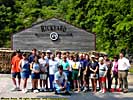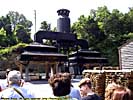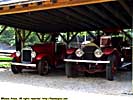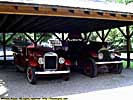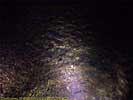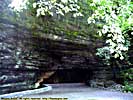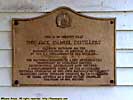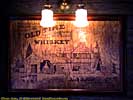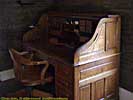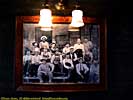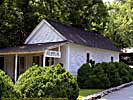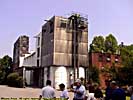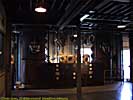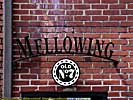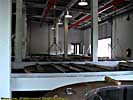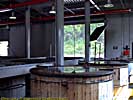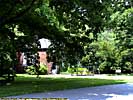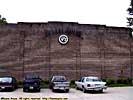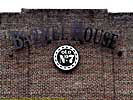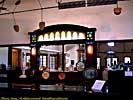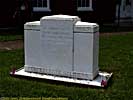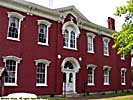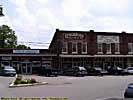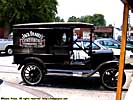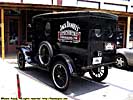Jack Daniel's Distillery
Lynchburg, Tennessee
| Introduction | Visitors Center | Rickyard | Retired Fire Engines | Cave Spring | Jacks Office | Grainery |
| Still House | Mellowing | Bottling | Barrel House | White Rabbit Room | Lynchburg | Almost Makers Mark |
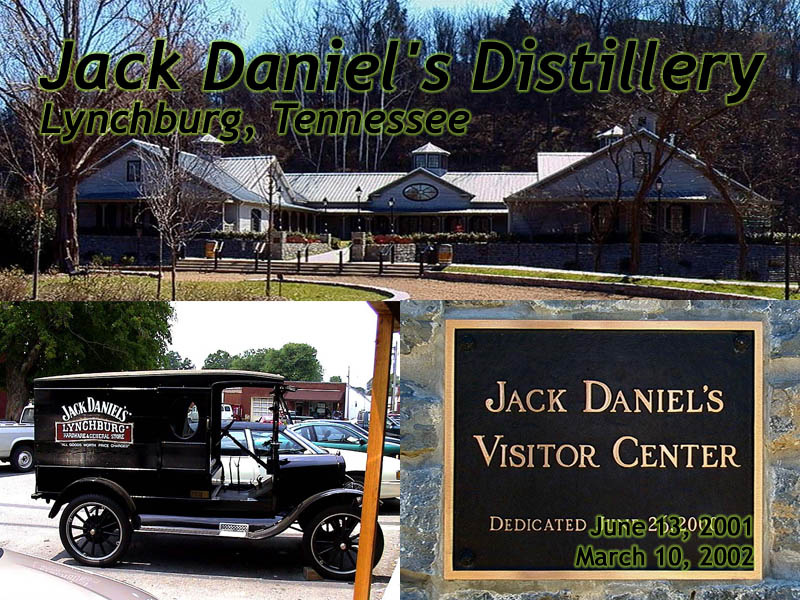
|
| Click to go directly to the slideshow |
Once you do find the place, you enter the lobby and register with the desk. You'll be given a color coded card and assigned to a tour group of no more than a couple dozen people. (Don't lose the card.) It's even kid friendly. I mean one of the biggest distillers in the country is located in a dry county, why shouldn't kids go on a tour for something they can't buy, anyway? :-)
Visitors Center (Exhibition Hall)
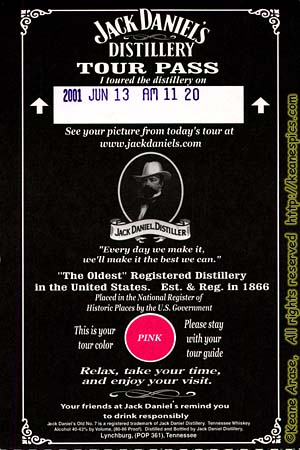
|
| You can time stamp your tour card at the end of the tour so you can find your group picture... |
A part of the Visitor's Center is about, of course, Jasper Newton Daniel, a.k.a. Jack Daniel. He was a short guy, who's demise at 61 years old was the result from kicking a safe he couldn't get open. Yep. And you even get to see the safe on the tour in Jack's old office. There are also some of the awards the product has won over the years.
It also shows a summary of the entire Tennessee Whiskey making process from start to finish, including things not on the tour (like what the whiskey (and the barrel) looks like at different stages of aging). But seeing an exhibit versus the actual industrial process is quite different...
Once your tour is announced, you meet your Tour Guide in a small theater for a short movie about the history of the company and the Master Distillers the company has had over the years. After that you board a bus, (one of those small airport-to-hotel courtesy type buses), and are driven out to the actual start of the tour. After departing the bus, the bus driver take a picture of your tour group, and is posted to their website so you can download it from home. (At the end of the tour, you can timestamp the card that was given to you at the Visitor's Center so you can locate the picture.) Nice touch.
It then becomes a walking tour (led and narrated by your guide), through then entire process of making Old Number 7 (and other Jack Daniel branded whiskeys) from start to finish.
A word about the tour guides. They're great! Of course, most tour guides I've witnessed (swamp tours in Honey Island, Louisiana and the Everglades in Florida; Colorado River tour in Utah; and the Jungle Boat Cruise in Disneyland and Disneyworld to name a few) are great, because, well, that's their job. But this tour comes with a southern, back country vibe to it, because, well, you're in rural Tennessee. They make it a very memorable (and informative) tour.
Apparently (and we was told this by our tour guide), there are five year-round tour guides. That's all they do. This guy had been doing it for over 15 years when I took the tour. During the tourist season, they hire seasonally employed guides due to the number of visitors. In 2001 Jack Daniel's hosted over 800,000 people on their factory tour. Try not to go during Spring Break.
Visitors Center (Exhibition Hall)
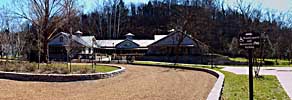
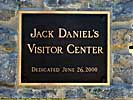
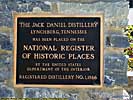

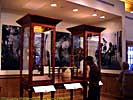
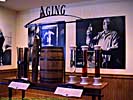
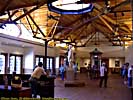




Rickyard

|
| My tour photo from 2002. Fewer people, but it was a Sunday, and a lot of things were shut down. |
Retired Fire Engines
They keep the Rickyard well away from the explosive mixture they create in the still house, so there's a walk (downhill) toward the Cave Spring and the Distillery itself.Jack Daniel's maintains their own fire department, and have some of their old fire engines on display on the way there.
Cave Spring
This is where the company actually gets their water, which has a high concentration of limestone in it, common to this area, which is why Tennessee and Kentucky are the whiskey centers of the U.S. The natural waters from these springs are supposedly the best for making distilled spirits.They siphon off what they need further into the cave, and the rest still flows out and will eventually enter the Gulf of Mexico...
The Old Administrative Office
You also get to visit the old administrative offices. Hard to believe the entire business was once run out of this building while Jack was alive. Not only is his old desk here, but so is he safe that led to Jack's demise.From here you'll pass by the grainery, but you really don't visit it, since it's only grain storage. So they discuss the mixture of grains they use for the corn mash in the administrative building...
Grainery
This is where the company receives the grain used to make the fermentable mash, which is 80% corn, 12% barley and 8% rye. It's ground, mixed with water and a portion of the previous, already fermented mash (thus the sour mash method of whiskey making) and allowed to ferment into beer in large vats in the Still House.Still House
In the front of the building are the computer controlled stills, which takes the fermented mash (around 4% alcohol) and extracts a 140 proof (70%) ethanol stream. You can feel a hangover forming just watching the liquid splashing through the glass housing.In the back of the Still House are the 48 fermenting vats, each is 25 feet deep and holds 40,000 gallon of fermenting, bubbling, sour mash. The tanks are in a rotation schedule, and is allowed to ferment for about 5 or 6 days before it's distilled.
Also note that when I was there, they didn't distill on Sundays, so if you want to see the distillation process, make sure you go on a Saturday or weekday.
"Mellowing"
The difference between a Tennessee Whiskey and a Bourbon Whiskey, is the Tennessee Whiskey is filtered through charcoal before being transferred to a barrel. It's supposed to make the whiskey smoother by removing some natural toxins from the distilling process. Gentleman Jack, one of their products, is filtered through this charcoal twice.The vats they use have 10 feet of charcoal in it (made in the Rickyard), and the distillate is dripped through before being put in a barrel for aging. Once the charcoal has outlived its usefulness, it is rinsed with water (which is redistilled to reduce waste) then sent out to a third party processor. If you ever see any "Jack Daniel" charcoal for a grill, some of it may actually be from this process.
The top of the vat is transparent so you can see the still clear alcohol drip into the charcoal. The lid is also kinda loose, and they let you inhale the goodness so you can clear your sinuses...
Bottling
They have a bottling line here, but it more for specialty bottles, like the Single Barrel line of whiskey they produce. (Single Barrel is just that. The tasters pick barrels which have aged particularly well, and you buy the entire barrel. The whiskey is bottled (and once diluted to 80 proof, yields some 240 - 750 ml. bottles) with personalized collars on each, and you even get the barrel. While buying an entire barrel of whiskey might be a bit much for most individuals, I've been able to get a bottle at Sam's Club. They also go to restaurants, liquor chains, clubs, etc. Otherwise, Old Number 7 is a blended whiskey for consistency.)Their mass produced lines are bottled at a bottling factory. I'm not even sure it's on site, since it makes more sense to have it closer to the barrel houses.
They also hold a question and answer session here, and a small talk about how much the revenuers get from each barrel, and how much Jack contributes to the Feds for the privilege of making whiskey... :-)
Barrel House
The last stop before returning to the Visitors Center is a Barrel House, where they age the whiskey. It used to be the Visitors Center prior to the current one (which was new when I was there in 2001), and was converted back into a real barrel house. It's really the only stop which is out of sequence on the tour, since it should come before bottling, but there you are.This barrel house holds 6,000 barrels, and they have dozens if not hundreds of barrel houses. Remember that 70% alcohol is flammable, and a barrel house fire is a catastrophic event, so they're kept apart from one another. (Even the trucks that transport the barrels have fire hazmat symbols on 'em.) But if you've ever been in a barrel house, you know they smell wonderful. Heh.
The barrels are made of oak and are charred on the inside so the raw alcohol starts to take on the amber color from the char and from the wood itself. The barrel houses are specifically unheated, so the cold and heat from the changing seasons forces the alcohol into the wood and extracts the resins and other chemical compounds like any other good solvent would. (Of course, most other solvents of this type would kill you if you drank it.) If you look at a cut portion of a barrel, you can see how far the alcohol penetrated the wood.
Jack Daniel's only uses a barrel once, then the owning company (who also produce the barrels) resells them to other distilleries.
White Rabbit Saloon
The final stop on the tour is in the White Rabbit Saloon, where the strongest drink they serve is coffee. (You're in a dry county, remember.) There are machines that can time stamp your tour card here, so you can locate your group picture later on their web site. (By now, you can probably e-mail the link to yourself. I was last there almost 15 years ago.)If you're not there on a Sunday, you can actually buy "Souvenir" bottles of Jack. (One of the tour guides joked about what it took to get that done in Nashville...) They're not plain bottles of Jack, but anniversary, award or specialty bottles.
They also have displays of all of their products. Hey, it's a factory tour, after all. You just can't try any of 'em.
Anyway, you can get back to your car straight from the White Rabbit, or you can go through the doors next to the "bar", and back into the Visitor's Center.
Lynchburg, Tennessee
Lynchburg is a company town, and to me the historic portion is just as much part of the Jack Daniel's experience as the factory tour. There's even a hardware store, where you can get everything from Jack Daniel clothing to playing cards to lighters to flasks... Just about anything that has the logo on it.The antique truck which was outside in 2001, was retired to the bottling building on the tour where the guide does his question and answers by 2002. The guide even mentioned that they decided they should protect the classic from the elements and was brought indoors.
Just don't go there on a Sunday, because nothing will be open. Bummer.
Almost Makers Mark
The only reason I have pictures of Makers Mark here, is because it was on the same trip as one of my Jack Daniel's stops, but only have four pictures because by the time I found the place the last tour had left. Loretto was more difficult to find than Lynchburg!The gift shop was still open, so at least I got to dip my own bottle of Makers Mark...
Makers Mark, Loretto, Kentucky
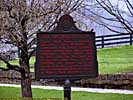
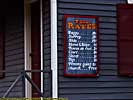


Yeah, finding Lynchburg is worth the effort if you're in the area and probably a lot easier to find with GPS, not common in 2001. Just don't do it on a Sunday, when much of the operation is shut down (and that includes the town of Lynchburg), because it's a Sunday.
I admit I'm not a real big fan of Jack, my whiskey is along the lines of Knob Creek Bourbon or a Highlands single malt scotch. Then too, I like my whiskey neat. But as a factory tour, Jack has the best. Educational, too. I first learned how to distill in a chemistry class, but seeing Jack Daniel's brought it up to an industrial level that was pretty amazing.
Trip Report: Jun 2001, Mar 2002.
| Return to: | State Index | Tennessee State Page | Miscellaneous Places |
|---|
- 04/30/2016 - Initial deployment
- April 2017 - Upgrade to v3.4.
- August 2022 - Upgrade to v5.0.
| Help! | About This Site | Contact Me |


